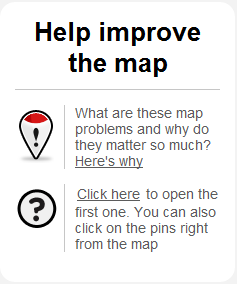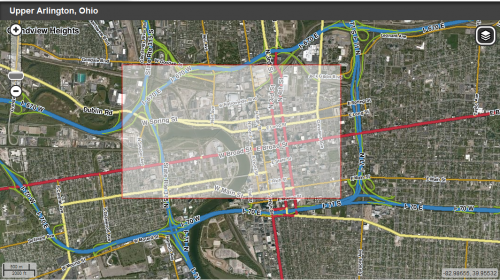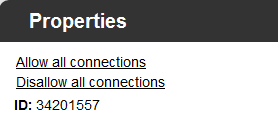No edit summary |
m (typo) |
||
| Line 70: | Line 70: | ||
[[Image:Button_redo.png|left]] Shortcut key: '''Ctrl+Shift+Z''' | [[Image:Button_redo.png|left]] Shortcut key: '''Ctrl+Shift+Z''' | ||
The Redo button will re-apply any changes which have been recently undone with the | The Redo button will re-apply any changes which have been recently undone with the Undo button | ||
==Delete Button== | ==Delete Button== | ||
Revision as of 14:26, 26 January 2012
Map Editor Layout
There are four main areas of the Map Editor:
- Toolbar
- Properties Toolbox
- Layers (overlays) selector
- Map Display Area
- At the top, a toolbar with a search box, and buttons to Save, Undo, Redo, Trash and Add
- At the left are two elements:
- In the background, is
- Your username and current points total
- Your editing level
- My Places, which, when expanded, can show your Areas you have edit rights, and your Drives (archived routes)
- Below all that is some information about helping to improve the map in various ways
- In the foreground is an expandable toolbox which displays the properties of the currently selected object. Any editable properties are edited from this properties toolbox.
- In the background, is
- At the top of the main display area below the toolbar, is a dark gray bar which displays:
- To the left will be the current city and state (US).
- To the right is an indicator showing the number of changes currently executed on the map which need to be saved.
- Immediately to the left of the unsaved changes indicator is a loading indicator which appears only when map elements are still loading.
- In the top-right corder of the main window, inside the main window space, is the activator for the layers menu.
- The map display area, which takes up the majority of the space, is the map display area. This has the ability to display aerial/satellite photography, streets, junctions, landmarks, red light/speed cameras, GPS tracks, map problems, and your editable area. All of these are discussed below
- At the bottom of the main window are the following elements:
- The left corner is the scale indicator for the current zoom level
- At the right side is the latitude and longitude display of the mouse cursor's current location
- At the far right is the permalink button.
Map Editor Tool Bar
Search box
In the wide search box, you can enter an address, city, state, country, landmark or point of interest, or a combination of those. After hitting Enter or clicking the Find button, you will either be taken to the only result, or be given a list of matches to select from.
For example, entering "757 Mohawk St, Columbus, OH" will center the map and drop a search marker directly on that address.
However, searching for "main st, new york" will get you a list of matches to select from.
Add Button

Shortcut keys: i, o, or u
The Add Button is not reall a button but actually a menu. You do not need to click on it, just hover your mouse over it and the menu of objects you can add will appear below.
From this menu, you can add a Road, a Roundabout, or a Landmark. Details for each of these actions are found in the Editing Manual.
Save Button

Shortcut key: Ctrl+s
The Save button saves all of the current changes you have made. This process is a little more complex than this sounds, but that is what it does. In order to save properly, your browser receives messages back from the Waze server if there were any errors. If there is an error when saving, the editor will try to give you a detailed error message and a suggestion to fix it. The map view will also show the error area highlighted in a bright circle.
Once the Save button is clicked and the save operation completes successfully, you cannot Undo previous changes with the Undo button.
Undo Button

Shortcut key: Ctrl+Z
The Undo button will undo unsaved successive previous changes with each click. IMPORTANT: Once the Save button is clicked and the save operation is complete, the Undo button has no effect on previous changes.
A change can be deleting a geometry node from a segment or renaming a landmark. It can also be a change to multiple objects at once. For example, if you multi-select 25 street segments to change them from No Entrance to 2-way, that is considered a single change. Therefore, one click on Undo will undo that change for all 25 segments.
Redo Button
Delete Button

Shortcut key: Delete (Del)
The Delete button will delete, or trash, any currently selected objects. If you have multiple objects selected, you will be prompted to confirm the multiple deletion. The only object you can currently multi-select is segments.
Undo does work for deleted objects. Objects are not actually deleted until the Save button is clicked. After that, you cannot Undo any edits or deletes.
Left Background
At the left side of the window is an area which is both informational and functional. The sections are discussed below.
User information
Editing Permissions
My places
Below your editing permissions is a section called "My places" which, when expanded, allows you to view either Areas you can edit, or your Drives (routes) you've done with Waze running.
Areas I can edit
This list is of the various defined areas of which you are an area manager.
Drives
Drives allows you to see the history of routes you've driven with Waze running. Clicking on an entry will center the map along your route and will zoom out to try and fit your entire route on the screen. Routes over 20miles are will not fully fit. From the route display, you can choose to create any segment of your drive which does not already exist. These segments are shown in red. Be careful not to create roads over existing segments. Check the map first!
Help improve the map

Until the "My places" section is expanded, the "Help improve the map" section is visible as the last element at the left side of the window. This is where Waze puts some information about how the map editors can help to improve the map.
Properties Toolbox

The properties toolbox is initially shown as a tab which expands to the left when clicked. When there is no object selected on the map, the drawer looks empty. When an object is selected, the contents of the Properties drawer change to reflect the available properties, both editable and non-editable, of that object. Therefore, the look of the drawer when a Landmark is selected is quite different from that of a street segment.
Map Display Area
All the layers currently selected for display show up in the map display area. The map display areas takes up the majority of the browser window. Any object displayed is selectable and editable, depending on your editing rights in the area you are viewing. Select a street and change its geometry. Select a landmark and change its name. Add a road where one should be, or delete a road which should no longer appear.
There are six main component controls or displays in the corners of the map display area:
- Info Bar
- Layers
- Zoom Control
- Scale
- Lat/Lon
- Permalink
Info bar
Just below the main toolbar, there is a dark gray area which runs the width of the map display area.
- The left side will display the current city and state (US) or city and country (world).
- The right side displays whether the editor is still loading any layers, such as road images or GPS points.
- The far right side displays the current count of unsaved edits.
Layers
On the right-side of the main window, you will see this small icon: ![]()
When clicked, it expands to display the layers or object types which are available for display on the main map. When the box next to the layer name is checked, then that layer is active and being displayed.
Each of the layers is discussed in more detail later, but a short desription of each is directly below.
Bing Aerials
Waze uses aerial and satellite photography provided by Bing (or VirtualEarth).
Cities
City boundaries as defined by segments assigned to that city are shown in different colors. This layer is helpful in finding segments which are set to the wrong city. Until an area is heavily edited an updated, some city boundaries are likely to be overlapping or appear to be unassociated with any segments.
Roads
Roads are all of the streets, alleys, highways, and freeways which make up the driveable street system in Waze. Depending on the zoom level, some street types are not displayed so that the map is not too cluttered.
GPS points
This layer will show tracks from Waze users as they drive with Waze running. Waze records and plots the GPS coordinate of drivers. This layer is useful for relatively accurate placement of new or moved roads when aerial photography is not yet updated. GPS points appear in the map editor as colored arrows. The direction of travel for a GPS point determine its color, so that all drivers going the same direction will show their points in the same color. This makes it easier to determine errant GPS points, or where a road on the map doesn't follow the actual path of vehicles.
Landmarks
Landmarks are also known as POIs (Points of Interest). These can really be just about anything, but tend to be things like parks, gas stations, cemeteries, transit stations, etc. Landmarks appear in the map editor as colored shapes.
(Speed) Cameras
Speed cameras, red-light cameras and dummy cameras are shown on this layer. Drivers report camera location and type, and a map editor is required to confirm the existence of the camera, precise location and direction the camera is point before it will appear on the client. Confirmed cameras will pop up a visual and audible alert in the Waze app when approaching a speed or red light camera.
Speed Cameras
These cameras are permanently mounted systems, triggered by vehicles traveling beyond the posted speed limit. When triggered, it takes a photo of your car, license plate, driver and you receive a citation in the postal mail. Speed cameras in Waze are uni-directional.
Red Light Camera
These cameras are permanently mounted systems at intersections. They are triggered when a vehicle is illegally in the intersection when the traffic control light is red for their direction of travel. Different countries and US states operate them differently in terms of when they are set to be triggered. Red light cameras in Waze are uni-directional, so for a fully-covered 4-way intersection, four red light cameras are required to notify drivers in all directions.
Dummy Cameras
Some locations will have what looks to be a speed camera set up, when in fact it is a fake camera housing only meant to deter drivers from exceeding the speed limit.
Problems

Shortcut key: Shift+p
The Waze servers are constantly analyzing driver's GPS tracks to determine when there might be a problem with the map and uses the Problems layer to alert the editors. Some types of problems tracked are missing roads, incorrect turns allowed at intersection, wrong direction of road.
Update Requests

Shortcut key: Shift+u
These are user-submitted map issues while on the road or from LiveMap. This marker shows the location the user reported the issue from. The user's driven route for a distance before and after the reported location will be shown in bright green. If Waze was in navigation mode at the time of the report, the requested route for a distance before and after the reported location will be shown in purple, with markers along the route with the turn direction given to the user.
- For details about working with Update Requests in Waze Map Editor, please see Update Requests in Waze Map Editor.
Editable areas
Where you can edit is determined primarily by where you have driven. Edit rights are granted within a one-mile radius of where you have driven with Waze running. Your editable area is shown in lighter-colored areas surrounded by a black border. Users who are Area Managers will also see their managed areas in a colored highlighted area.
Zoom Control

Shortcut key: Shift+UpArrow, Shortcut key: Shift+DownArrow
In the upper left corner, the zoom control is one way to adjust the zoom level, or altitude, or the map display area. Clicking + will move in closer, showing more detail. Clicking - zooms out/higher and removes detail. You can also click and drag the selector in between the + and - buttons.
Scale
Lat/Lon
Permalink
Outside of the lower right corner of the map display area is the underlined word permalink. The permalink changes any time the map moves or objects are selected and deselected. It is a link to the exact view you are currently seeing in the map display area. You can click it to refresh the map area, or you can right-click and copy the address of the permalink to share via email or in the Waze forums.
- Move around the map by clicking and dragging on the map itself
- Keyboard arrow keys will pan the map
- There are four ways to zoom the map:
- There is a zoom controller on the top left-hand corner of the map. You can either drag the slider up and down, or click on the + and - buttons.
- Double-clicking any point on the map will zoom in one level and center the map on that point.
- Scrolling up with your mouse wheel will zoom in on a certain point, and scrolling down will zoom out, keeping the mouse pointer's location in the same location. On Macintosh systems with a track pad or similar mouse device, dragging left and right performs this action
- Hold the Shift key down and then click and drag a rectangle on the map. The map will then zoom in onto the selected area:














